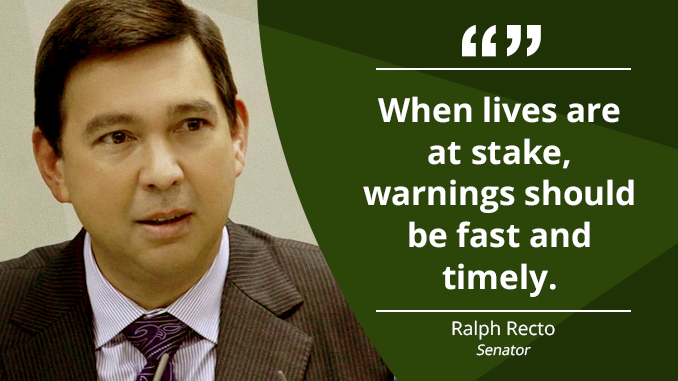If flood and storm text alerts have been few and infrequent, blame it on the circuitous way that proposed messages are “processed and approved before they are sent out,” Senate President Pro-Tempore Ralph Recto said.
“It is not the fault of telcos,” Recto said, “but the process that these alert warnings have to go through before they’re cleared for dissemination, free of charge.”
The veteran legislator said the process could be accelerated if the National Disaster Risk Reduction and Management Council (NDRRMC) is taken out of the equation and agencies such as Philippine Atmospheric, Geophysical and Astronomical Services Administration (PAGASA) and the Philippine Institute of Volcanology and Seismology (PHIVOLCS) are allowed to communicate directly with telcos.
“Under present rules, only the NDRRMC is the authorized generator of alerts,” the seasoned lawmaker explained.
“Sa ngayon kasi PAGASA has to send a warning to NDRRMC, sa Operations Center nito, then the proposed emergency warning will be sent to the NDRRMC Executive Director for approval, and only if he has approved it can the NDRRMC send it to telcos for text blasting,” the senator from Batangas said.
“This is a cumbersome process. Why should there be a middle man in a process that should be characterized by speed?” he said.
“Why not just allow PAGASA, in the case of typhoons, or PHIVOLCS, if it concerns earthquakes, to communicate directly with telcos? Bakit ang message routed pa through NDRRMC? Bakit hindi na lang hotline between PAGASA and Smart or Globe?” Recto said.
“If a tsunami is racing towards a province at the speed of a jet plane, bakit ang mensahe dadaan pa ng Camp Aguinaldo? That should be delegated to the responsible agency. When lives are at stake, warnings should be fast and timely,” Recto said.
Besides, the legisltor said, NDRRMC has no “value-added input” to an alert “based on science and crafted by scientists.”
“They cannot veto science. Ang pwede lang siguro maitulong ay sa editorial, on crafting the required number of characters in a text message or a tweet. But the PhDs in PAGASA can do this,” the lawmaker said.
The senator said the law mandating emergency alerts and warning messages in times of disasters, Republic Act 10639, does not identify or empower NDRRMC “as the final clearing house, walang provision na ganoon.”
“Nilagay na lang sa IRR ‘yan,” Recto said.
He added that the MMDA should also be allowed to set up a hotline with telcos and be named as one of the agencies who can send emergency alerts.
“They have people on the ground, flood watchers, kaya kung lampas baywang na ang baha, sila ang may alam. PAGASA can only measure the rainfall. But height of floodwaters, MMDA ang may alam diyan,” Recto said.
RA 10639 states that in the event of an impending tropical storm, typhoon, tsunami, or other calamities, mobile phone service providers are mandated to send out alerts at regular intervals.
The alerts shall be at no cost, whether direct or indirect, to the consumers; and shall be included as part of the service providers auxiliary service, the law states.
Under the law’s IRR, sources of information aside from PAGASA and PHIVOLCS are the Philippine Nuclear Research Institute,Mines and GeoSciences Bureau, Bureau of Fire Protection, Philippine National Police, Armed Forces of the Philippines, and the Department of Health.

